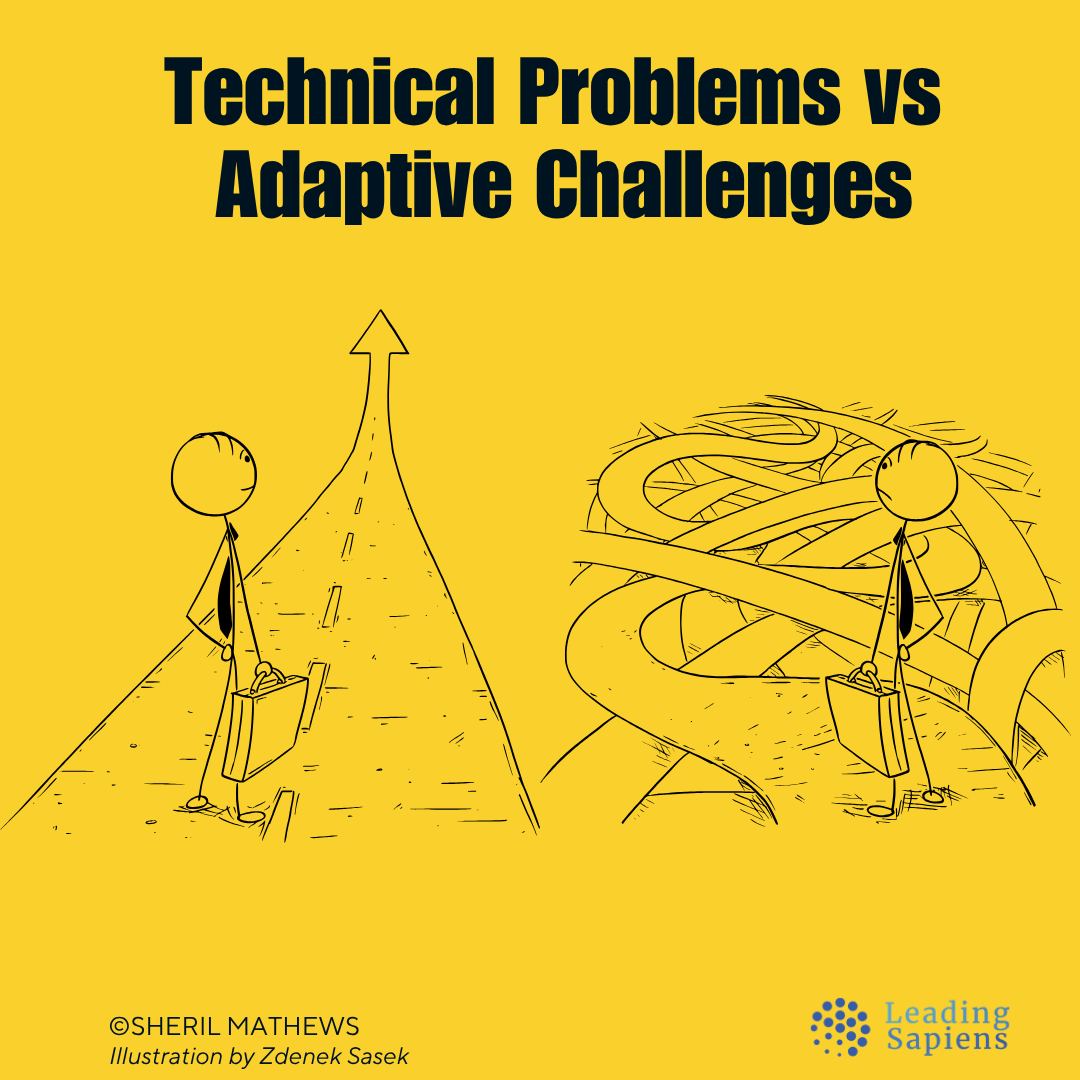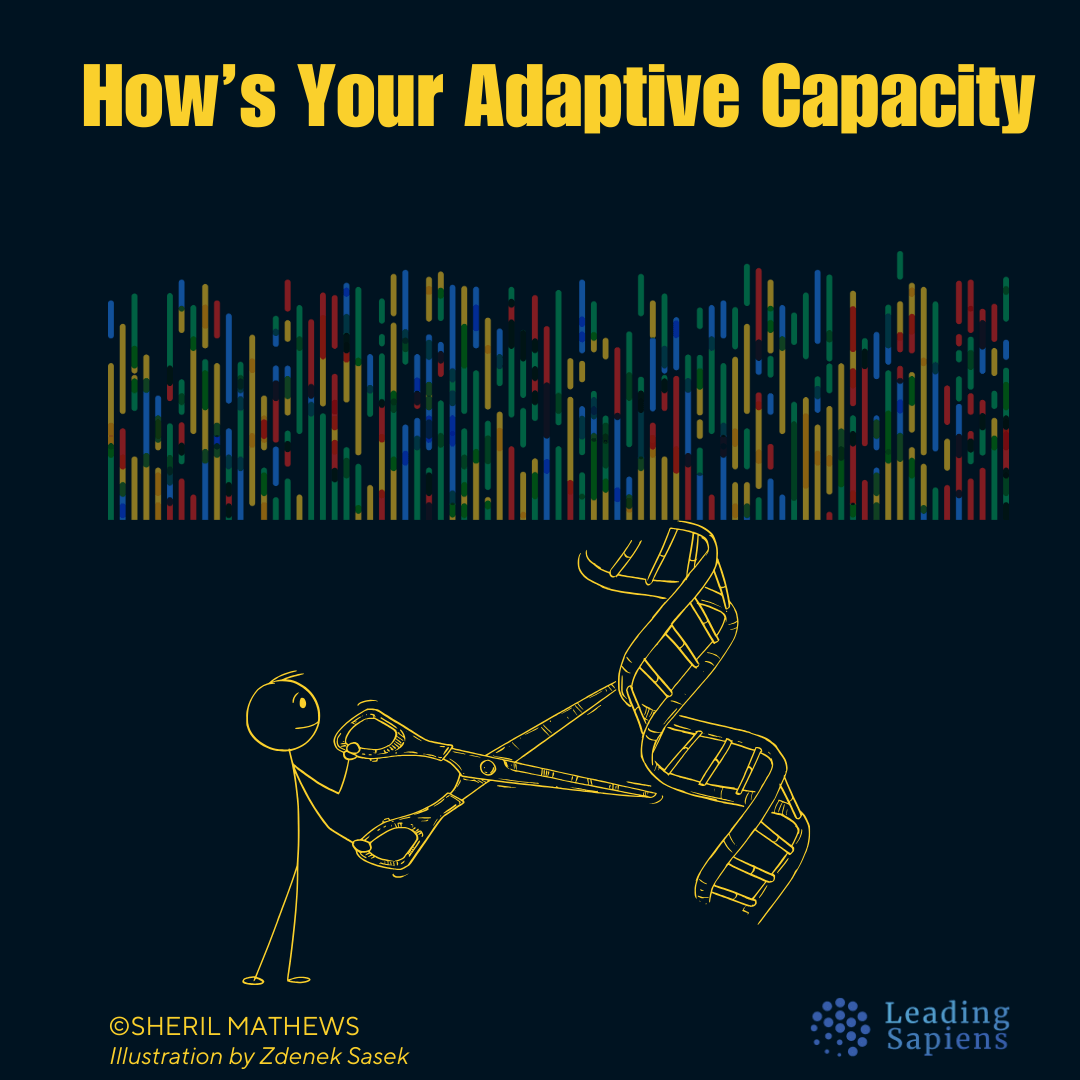Most leadership models sound good until they’re tested in the wild. A crisis, a reorg, or conflicting loyalties can easily expose the gaps in any conventional playbook. It’s because many vexing problems aren’t technical, they’re adaptive: people must let go of something they value, learn something new, or redefine success. They require what Ron Heifetz at Harvard calls Adaptive Leadership.
Rather than a style or personality trait, adaptive leadership is a practice. It’s the discipline of mobilizing people to confront difficult realities and increase their collective capacity to adapt. Heifetz put it bluntly: leadership is dangerous work. It threatens what people hold dear and disappoints their demand for certainty. You are a target because your job is to surface the very issues others are working hard to avoid.
This is the first in a three-part series on Heifetz’s adaptive leadership framework. In this piece, I define what it is and spell out what makes it distinct. A companion piece examines the distinction between technical and adaptive challenges. The final one turns to practices — the specific behaviors and interventions that bring adaptive leadership to life. Together, they provide a practical methodology for leaders facing challenges that can’t be solved by expertise or authority alone.
What is adaptive leadership?
To define adaptive leadership, Heifetz and colleagues [1] use the analogy of evolutionary biology to emphasize its criticality to modern organizations. The natural world and organizations are more alike than we realize.
Heifetz explains:
Adaptive leadership is the practice of mobilizing people to tackle tough challenges and thrive. The concept of thriving is drawn from evolutionary biology, in which a successful adaptation has three characteristics: (1) it preserves the DNA essential for the species’ continued survival; (2) it discards (reregulates or rearranges) the DNA that no longer serves the species’ current needs; and (3) it creates DNA arrangements that give the species’ the ability to flourish in new ways and in more challenging environments. Successful adaptations enable a living system to take the best from its history into the future….
Adaptive leadership is specifically about change that enables the capacity to thrive. New environments and new dreams demand new strategies and abilities, as well as the leadership to mobilize them. As in evolution, these new combinations and variations help organizations thrive under challenging circumstances rather than perish, regress, or contract.
Leadership, then, must wrestle with normative questions of value, purpose, and process. What does thriving mean for organizations operating in any particular context? In biology, thriving means propagating. But in business... signs of thriving include increases in short- and long-term shareholder value, exceptional customer service, high workforce morale, and positive social and environmental impact. Thus adaptive success in an organizational sense requires leadership that can orchestrate multiple stakeholder priorities to define thriving and then realize it.
Successful adaptive changes build on the past rather than jettison it. In biological adaptations, though DNA changes may radically expand the species’ capacity to thrive, the actual amount of DNA that changes is minuscule. More than 98 percent of our current DNA is the same as that of a chimpanzee: it took less than a 2 percent change of our evolutionary predecessors’ genetic blueprint to give humans extraordinary range and ability. A challenge for adaptive leadership, then, is to engage people in distinguishing what is essential to preserve from their organization’s heritage from what is expendable. Successful adaptations are thus both conservative and progressive. They make the best possible use of previous wisdom and know-how. The most effective leadership anchors change in the values, competencies, and strategic orientations that should endure in the organization.
Organizational adaptation occurs through experimentation. In biology, sexual reproduction is an experiment: it rapidly produces variations—along with high failure rates. As many as one-third of all pregnancies spontaneously miscarry, usually within the first weeks of conception, because the embryo’s genetic variation is too radical to support life. In organizations, the process appears similar. Global pharmaceutical giants must be willing to lose money in failures to find the next profitable medicine. Those seeking to lead adaptive change need an experimental mind-set. They must learn to improvise as they go, buying time and resources along the way for the next set of experiments.
Adaptation relies on diversity. In evolutionary biology, nature acts as a fund manager, diversifying risk. Each conception is a variant, a new experiment, producing an organism with capacities somewhat different from the rest of the population. By diversifying the gene pool, nature markedly increases the odds that some members of the species will have the ability to survive in a changing ecosystem. In contrast, cloning, the original mode of reproduction, is extraordinarily efficient in generating high rates of propagation, but the degrees of variation are far less than for those in sexual reproduction. Cloning, therefore, is far less likely to generate innovations for finding and thriving in new environments.
The secret of evolution is variation, which in organizational terms could be called distributed or collective intelligence. Likewise, adaptive leadership on economic policy would want to diversify an economy so that people are less dependent on one company or industry for sustenance. For an organization, adaptive leadership would build a culture that values diverse views and relies less on central planning and the genius of the few at the top, where the odds of adaptive success go down. This is especially true for global businesses operating in many local microenvironments.
New adaptations significantly displace, reregulate, and rearrange some old DNA. By analogy, leadership on adaptive challenges generates loss. Learning is often painful. One person’s innovation can cause another person to feel incompetent, betrayed, or irrelevant. Not many people like to be “rearranged.” Leadership therefore requires the diagnostic ability to recognize those losses and the predictable defensive patterns of response that operate at the individual and systemic level. It also requires knowing how to counteract these patterns.
Adaptation takes time. Most biological adaptations that greatly enhance a species’ capacity to thrive unfold over thousands, even millions, of years. Progress is radical over time yet incremental in time. It seems to work this way: a variant in the current population has the adaptive capacity in its time to venture a bit beyond the normal ecological niche for its kind, stressing itself near the margins of the range that it and its offspring can tolerate. … Although organizational and political adaptations seem lightning fast by comparison, they also take time to consolidate into new sets of norms and processes. Adaptive leadership thus requires persistence. Significant change is the product of incremental experiments that build up over time. And cultures change slowly. Those who practice this form of leadership need to stay in the game, even while taking the heat along the way.
There's a lot to unpack in this. I'll focus on a few key ideas.
How adaptive leadership is different
Adaptive leadership treats leadership as a process, not a position. Here are a few distinctions that differentiate it from common notions of effective leadership:
1. Leadership is dangerous
Real leadership is dangerous work because it requires surfacing what people most want to avoid. Adaptive challenges force loss: of competence, comfort, status, and identity. And loss creates resistance. People don’t fight change because they dislike new ideas; they fight because something they value is threatened.
That’s why exercising real leadership makes you a target. The pushback can be subtle — avoidance, scapegoating, withdrawal of support — or overt, like political attack or personal isolation. Systems have built-in defenses to protect themselves from disturbance, and the person leading the disturbance is the one the system turns against.
This signals you’re in the right territory. If your work isn’t provoking loss, it probably isn’t adaptive.
The danger also means leadership requires resilience. You cannot lead adaptively without exposing yourself. The question is not whether you’ll face risk, but if you can survive it long enough to stay in the game. That survival depends on the discipline of what Heifetz and Linsky call “anchoring yourself” — practices that help you withstand the heat without being consumed by it.
Leaders who mistake danger for failure retreat too early; those who underestimate it burn out or get taken out.
Rather than being fearless, adaptive leadership means managing your own vulnerability while holding others in theirs. It requires you to “disappoint people at a rate they can absorb,” pacing the losses without collapsing under the pressure yourself.
If leadership feels entirely safe, it probably isn’t leadership at all.
2. Adaptive leadership orchestrates loss
Every adaptive challenge involves loss. People are asked to give something up — a familiar role, sense of competence, or a source of pride. These aren’t just inconveniences fundamental values and identities. Adaptive work always generates resistance as it rearranges what we hold dear.
Leadership is the orchestrating of this process of loss. It requires helping people discern what's essential to preserve, what to leave behind, and what new commitments to create. As in evolutionary biology, most of the DNA is carried forward; only a small portion changes. But those small changes make all the difference.
Adaptive leadership is not only about what works but also what matters. You cannot dodge value questions by framing everything as strategy or structure. Mobilizing people adaptively requires surfacing conflicts about purpose, loyalty, and identity, and pacing the process of letting go and creating anew.
Orchestration here is literal. Move too fast and people revolt or disengage. Move too slow and the system calcifies. The leader’s task is to hold the tension — applying just enough pressure for people to confront the loss, while providing enough containment to prevent collapse.
That’s why adaptive leadership is counterintuitive. Authority promises protection, while leadership forces exposure. But without orchestrating these losses, systems regress, avoid, or collapse under new conditions.
Leadership, from this perspective, is not about protecting people from loss but helping them navigate it.
3. Leadership operates on perspective
Heifetz’s enduring metaphor is the balcony and the dance floor. On the dance floor, you’re in the middle of the action — immersed in the noise, speed, and pressing expectations. On the balcony, you step back to see larger patterns: who’s moving with whom, which conflicts repeat, and what’s avoided.
Effective leadership requires balance. Too much time on the dance floor and you get consumed by the urgency of tasks, unable to distinguish noise from signal. Too much on the balcony and you lose credibility, cut off from the reality people are living. The work is in the rhythm between action and observation, engagement and detachment.
Leaders need diagnostic distance even in the heat of the moment. This is harder than it sounds. Most organizations reward speed, decisiveness, and availability. You’re socialized to respond, not pause. Yet without the capacity to step back, you can’t see the system at work.
Balcony work allows leaders to regulate themselves. When you’re caught up in the action, your own anxiety merges with the system’s. On the balcony, you can see your triggers more clearly, recognize when you’re hooked into dysfunction, and regain the steadiness to intervene deliberately.
Perspective is not a luxury but what makes leadership possible. Without it, you’re just another dancer, swept along by the music.
4. Leadership is experimental, incremental, and collective
Adaptation doesn’t arrive pre-formed as a grand design. In nature, it unfolds through countless small experiments — most of which fail. A genetic variation thrives only if the environment supports it. The same is true in organizations. Adaptive change is rarely a single breakthrough. Instead, it’s a series of trials,small wins, and lessons that accumulate over time.
This means leadership is less about perfect plans and more about imperfect experimentation. Those expecting clean solutions get frustrated. The evolutionary logic of adaptation requires space for pilots, rapid iterations, and course corrections. They help the system learn its way forward, instead of pretending the path is clear.
The incremental nature of adaptive work is unsatisfying. Authority pushes for answers, certainty and speed. Adaptive leadership resists that demand, holding the line long enough for progress to emerge through small wins. Each experiment — including failed ones — adds information to the system, nudging it toward new possibilities.
Because the odds of success rise with variation, effective leadership is inherently collective. It depends on diversity of thought and perspective. Monocultures — genetic or organizational — collapse under pressure. Voices at the margins, dissenters, and unconventional views are often sources of adaptation. The leader’s role is to expand the system’s capacity to generate them.
Thus, adaptive leadership is not the work of one heroic individual. Rather, it is distributed, fueled by variation, tested through experiment, and advanced incrementally. The discipline is to keep the experiments going, protect the diversity that feeds them, and resist the pressure for premature closure.
5. Leadership is sustained, not episodic
Adaptive challenges rarely resolve in a single initiative. Even with progress, new tensions surface, values collide, and the system resists in fresh ways. Adaptive work is less a project to complete and more a process that unfolds over time.
This required persistence is exhausting. People don’t stay engaged indefinitely; they want closure. Authority promises neat endings. But adaptive work reopens itself. It’s recursive, demanding leaders stay present through cycles of conflict, experimentation, and renewal.
For the leader, this means developing stamina and discipline. Heifetz and Linsky warn that leaders burn out when they expect adaptive change to move faster than it can. Cultures change incrementally and habits of avoidance run deep. Adaptive leadership requires you to stay in the game, sometimes for years, absorbing the frustration of slow progress without letting the work dissipate.
Adaptive leadership requires a steady, sustained presence. It asks you to pace yourself and create conditions for others to persist alongside you. Without continuity, your efforts collapse under fatigue. With it, small experiments compound into durable change.
Leadership is not a single act of courage but a sustained commitment to keep people engaged long after the excitement of the kickoff has faded.
Heifetz’s adaptive leadership endures because it identifies the work many leaders avoid: orchestrating loss, holding conflict, and sustaining people in disequilibrium long enough for them to grow.
It captures the brutal reality of leadership when authority fails: danger, uncertainty, disappointment, and risk.
Related Reading on Adaptive Leadership



References and Sources
- Heifetz, R. A. (1994). Leadership Without Easy Answers.
- Heifetz, R. A., & Linsky, M. (2002). Leadership on the Line.
- Heifetz, R. A., Grashow, A., & Linsky, M. (2009). The Practice of Adaptive Leadership.
- Adaptive Leadership: Making Progress on Intractable Challenges
- The Theory Behind Adaptive Leadership – Cambridge Leadership Associates
- The Work of Leadership – Harvard Business Review





